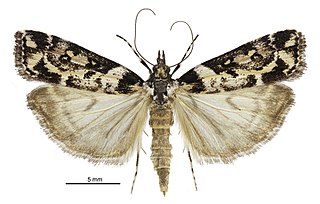
Acrapex albivena is a species of moth of the family Noctuidae first described by George Hampson in 1910. It is found in Africa, including South Africa.

Lichenaula lichenea is a species of moth of the family Xyloryctidae. It is known in Australia from the Australian Capital Territory, New South Wales and Queensland.

Eudonia diphtheralis is a species of moth in the family Crambidae. It is endemic to New Zealand.

Ichneutica oliveri is a moth of the family Noctuidae. It is endemic to New Zealand, found only in the South Island. However it has not been observed on the eastern side of that island from mid-Canterbury southwards to Southland. This species is distinctive and is unlikely to be confused with other closely related species. It inhabits tussock grasslands, shrubland as well as granite sand plains, all in the alpine zone. Adults are on the wing from December to March and are attracted to light. They have been observed feeding on the flowers of Hebe species. The life history of this species is unknown as are the larval hosts.

Gadira leucophthalma, commonly known as the beaked moss moth, is a moth in the family Crambidae. It is endemic to New Zealand. It is found in the south eastern side of the South Island down to Banks Peninsula. G. leucophthalma inhabits the foredunes of coastal areas. The larval host is unknown but it has been hypothesised that the larvae feed on moss. The adult moths are day flying although some specimens have been trapped at night via light traps. Adults are commonly on the wing from March to April. This species has been classified as Nationally Vulnerable by the Department of Conservation.
Catephia pyramidalis is a species of moth of the family Erebidae. It is found in Kenya.
Catephia poliochroa is a species of moth of the family Erebidae. It is found in Kenya.
Phostria albescentalis is a species of moth in the family Crambidae. It was described by George Hampson in 1918. It is found in the Democratic Republic of the Congo, Kenya and Mozambique.
Salbia ecphaea is a moth in the family Crambidae. It was described by George Hampson in 1912. It is found in Colombia.
Salbia endolasea is a moth in the family Crambidae. It was described by George Hampson in 1912. It is found on St. Vincent.
Sufetula obliquistrialis is a moth in the family Crambidae. It was described by George Hampson in 1912. It is found on the Louisiade Islands.
Sufetula polystrialis is a moth in the family Crambidae. It was described by George Hampson in 1912. It is found on the Louisiade Islands.
Sufetula pygmaea is a moth in the family Crambidae. It was described by George Hampson in 1912. It is found in Mexico.
Syllepte parvipuncta is a moth in the family Crambidae. It was described by George Hampson in 1912. It is found in Ghana and Sierra Leone.
Syllepte maculilinealis is a moth in the family Crambidae. It was described by George Hampson in 1918. It is found in Uganda.
Udea melanostictalis is a moth in the family Crambidae. It was described by George Hampson in 1916. It is found in Kenya.
Udea umbriferalis is a moth in the family Crambidae. It was described by George Hampson in 1918. It is found in Peru and Bolivia.
Udeoides nigribasalis is a moth in the family Crambidae. It was described by George Hampson in 1913. It is found in Kenya.
Dichomeris sevectella is a moth in the family Gelechiidae. It was described by Francis Walker in 1864. It is found in Guyana and Amazonas, Brazil.
Compsolechia nuptella is a moth of the family Gelechiidae. It was described by Cajetan Felder, Rudolf Felder and Alois Friedrich Rogenhofer in 1875. It is found in Peru and Amazonas, Brazil.



